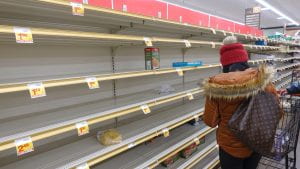 Since the COVID-19 virus has spread through the United States, you’ve no doubt found your local stores sold out of essential items, such as toilet paper, hand sanitizer and many food products.
Since the COVID-19 virus has spread through the United States, you’ve no doubt found your local stores sold out of essential items, such as toilet paper, hand sanitizer and many food products.
Jokes and memes fill the Internet making fun of the way people are clearing out grocery stores, especially of products not necessarily related to this specific virus, like toilet paper. What is going on here?
While Evidence-based Living wasn’t able to find a systematic review about panic buying, there is some research about why people buy more in a crisis, and suggestions for steps stores can take to reduce this problem.
One of the more comprehensive articles was published in the journal Manufacturing and Service Operations Management. In it, researchers develop economic models to explain why consumers engage in panic buying and what stores should do about it.
Not surprisingly, researchers find that people will stockpile a product for future consumption if the price is artificially low or if they feel uncertain about being able to get the product in the future. In our current situation, consumers are clearly worried that economic disruptions caused by the COVID-19 virus will make it difficult to buy essential staples in the near future.
The article also demonstrates that it is important for stores to respond to consumer behavior. In the case of consumers stockpiling to avoid risk in the future, instituting quotas on items in high demand is an effective way to manage resources.
A second similar paper in the journal Management Science finds that quotas are most important when the store can’t keep up with consumer demand.
Finally, a third paper in the Journal of Intelligence investigated a specific case of panic buying of candles in China in 2012 due to a rumor that the earth would fall into darkness for three days when the Mayan calendar came to an end.
The study took a careful look at how the dissemination of complex information influenced consumer buying patterns. The researchers found that panic buying progresses in stages based on the information shared by key individuals, and that government and public figures can influence purchasing patterns by sharing factual information.
The take-home message: The evidence shows that panic buying in disaster situations is driven primarily by the fear that there will be a shortage in the future. If there is a true shortage of an item, it’s good practice for stores to institute quotas. They should also clearly communicate when there is plenty of a resource to go around. These are essential steps to quell panic buying.
Visit Cornell University’s Bronfenbrenner Center for Translational Research’s website for more information on our work solving human problems.



Speak Your Mind